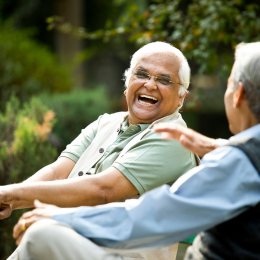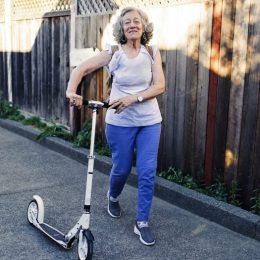3 Breathing Exercises Older Adults Should Do Every Day
Are you breathing all wrong? It could be making you tired and hurting your health. Here’s the fix.

Let’s try a little experiment. Stand with your side facing a mirror, and take a big, deep breath. What moved? Your chest or your stomach? If you’re like most people, your chest.
And that’s exactly why you need to incorporate breathing exercises into your daily routine.
When you breathe “with your chest,” the muscles of the chest, back, and neck contract to draw air into the lungs. But when you breathe “with your stomach,” the diaphragm—a large muscle between your chest and digestive organs—contracts to accomplish the same thing but better.
“The diaphragm is much stronger than the chest muscles and over two times as efficient at bringing air into the lungs,” explains Ray Casciari, M.D., a pulmonologist at St. Joseph Hospital in Orange, California. If your chest is the only thing moving with each breath, you’re only filling the very top of your lungs with the oxygen your body needs to survive and thrive.
Research in the Primary Care Respiratory Journal shows that about one in 10 adults experiences hyperventilation (a.k.a. dysfunctional breathing). Marked by shallow, frequent chest breathing, it results in everything from pain and breathlessness to fatigue and unsteadiness. “As your body literally becomes oxygen-deprived, you may have to slow or sit down,” says Budd Coates, author of Running on Air: The Revolutionary Way to Run Better by Breathing Smarter.
What’s more, chest breathing is linked to higher levels of anxiety, which increases blood pressure and other markers of heart disease, says Pennsylvania-based family medicine physician Rob Danoff, D.O. He has his older patients perform diaphragmatic breathing exercises both before bed and first thing in the morning. “Many older adults complain of trouble falling asleep,” he says. “Plus, heart attacks are most common—and tend to be the most serious—in the morning when stress hormones are at their highest.”
Dr. Danoff notes that diaphragmatic breathing dials down the body’s fight-or-flight sympathetic nervous system response while turning up the body’s rest-and-digest parasympathetic nervous system. This helps lower blood pressure and even blood sugar levels. Recent research out of Stanford University suggests that this may be because, unlike chest breathing, deep breathing does not activate the neurons that fire up the brain’s arousal center.
“Unfortunately, as people age, muscle tone tends to deteriorate and fat levels increase, which can affect how deep people are able to breathe with the diaphragm,” Coates says.
But it’s not all bad news. You can strengthen your diaphragm and literally breathe easier with these three exercises.
Exercise #1: Daily Cardio Burst
High-intensity exercise does more than put your heart to work. “When you exert yourself to the point that you are a little short of breath—meaning you can only speak in short phrases—your body will naturally recruit your diaphragm to increase the exchange of oxygen and carbon dioxide,” explains Dr. Casciari.
The next time you get a little out of breath—whether in an exercise class, when taking the stairs, or during a walking workout—pay attention to your breathing and how your abdomen feels. That’s the feeling of deep, diaphragmatic breathing. “I think it’s a good idea to get short of breath for at least a little while every day for overall health,” Dr. Casciari says.
If you have asthma, chronic obstructive pulmonary disease (COPD), or another lung condition, exercise can improve your health and reduce symptoms. Talk to your doctor about how to exercise safely.
Exercise #2: Belly Grab
Lie flat on the floor, and place one hand on your stomach and one on your chest. Begin breathing, concentrating on moving the hand on your stomach while keeping the hand on your chest still. On each exhale, concentrate on squeezing your abs to force out the air, Dr. Danoff says.
Perform this exercise for one minute at least twice a day. As you get comfortable, try performing it in a seated or standing position. Ideally, you should breathe this way 24/7. And the more you practice, the easier and more automatic it will become.
Subscribe to our newsletter
It's quick and easy. You could be one of the 13 million people who are eligible.
Already a member? Click to discover our 15,000+ participating locations.
Follow Us
Exercise #3: Car Sing
Don’t be bashful—no one can hear you! “Singing is a wonderful exercise for the diaphragm,” Dr. Casciari says. “The louder, the better.” After all, reaching new decibels and belting out long verses requires big inhales.
Dr. Casciari notes that it’s easiest to take deep, diaphragmatic breaths in cool, less-humid air, but singing in the shower is great too.
Yoga Can Deepen Your Breathing Too
Yoga is a great way to practice deep breathing and learn to use it to help power your daily movements, explains Jennifer Caudle, D.O., a family medicine physician and an associate professor at Rowan University School of Osteopathic Medicine.
Your instructor will guide you on how to use your core muscles, including your diaphragm, to exhale deeply into postures and inhale fully to anchor yourself. Tai chi is a low-impact activity with a similar mind-body approach that can help relieve stress and teach deep breathing techniques.
Take Your Favorite SilverSneakers Classes Online!
SilverSneakers members can access live fitness classes and wellness workshops through SilverSneakers LIVE. See the latest schedule and RSVP for classes here.
Not a member? If you have a Medicare Plan, it may include SilverSneakers—at no additional cost. Check your eligibility instantly here.





